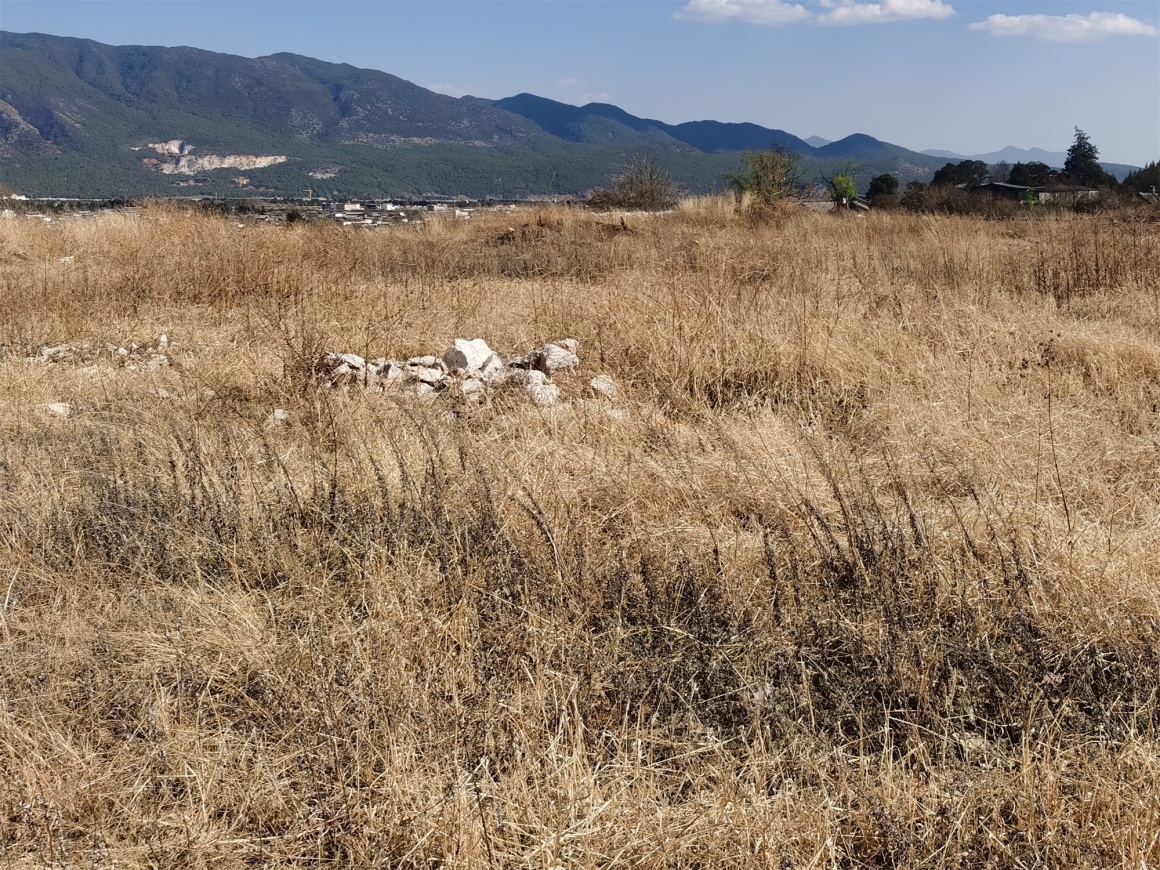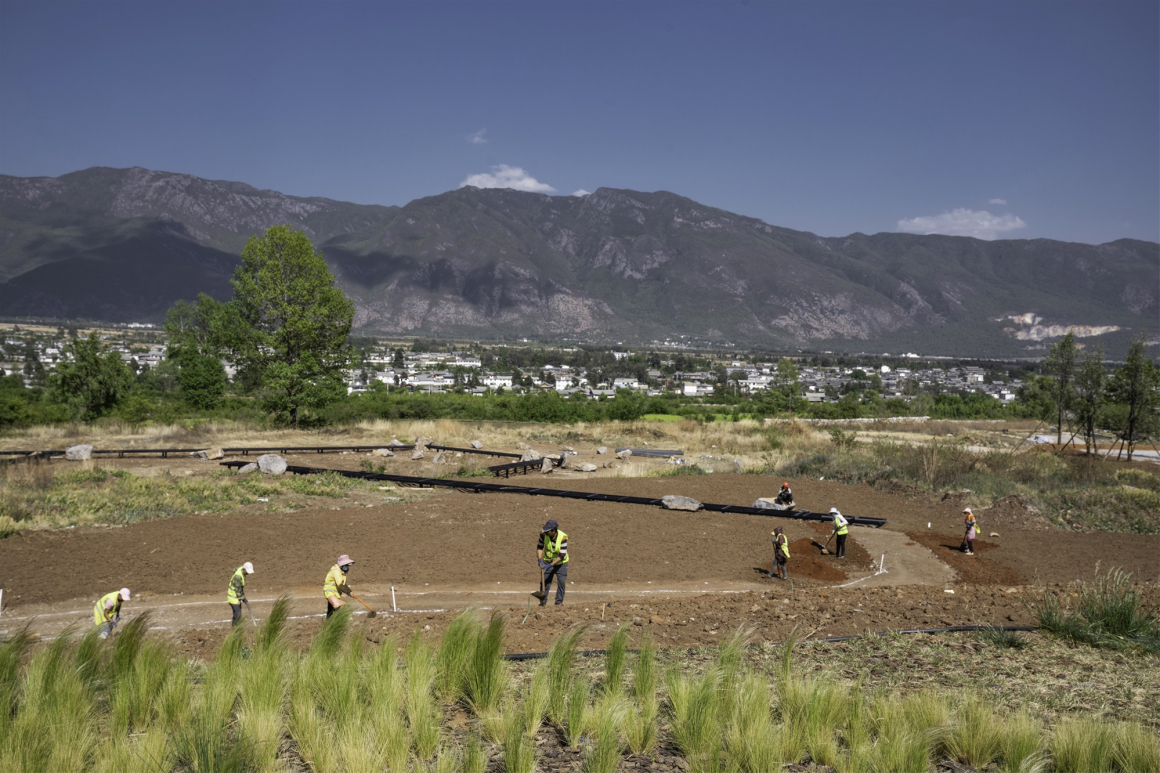本文由 Z’scape 致舍景观 授权mooool发表,欢迎转发,禁止以mooool编辑版本转载。
Thanks Z’scape for authorizing the publication of the project on mooool, Text description provided by Z’scape.
致舍景观:“继HYLLA高山花园建成后,在远离建筑的许拍以东,在更接近乡土和自然的3公顷土地上,我们和业主都有了试图营建一个更低维护的、以克制的设计介入最大程度地还原本土植被花园的构想。
Z’scape:”Following the completion of HYLLA Alpine Garden, the client and we had the vision of attempting to create a lower maintenance garden with limited design intervention to maximize the restoration of native vegetation on a 3-hectare site to the east of Xupai, away from the buildings.
▽项目视频 Video

自2020年设计启动到2021年5月荒野花园和草甸剧场落成,距今天也正好建成1年。在这个有生命力的原始和艺术的空间里,我们将自然的野生无序与人工的几何秩序之间建立对比与融合;本着对景观生命周期完整的认识和探索,在时间维度中真实纪录花园里的一岁与枯荣。在其中感受生命的萌发,也感受生命的凋零;在四季变迁的时间轴里见证自然修复的过程,用土地自我迸发出的原始力量来触动人心。在有疫情阴霾的当下,愿自然演替的荒野景观给人们带来了一抹绿色的希望。”
—致舍景观主持设计师周梁俊
The design started in 2020 and the Wilderness Garden and Amphitheater were finished in May 2021, precisely a year ago. In this living, primitive and artistic space, we establish a contrast and marriage between the wild disorder of nature and the geometric structure of artificiality. In the efforts to understand and explore the complete life cycle of the landscape, we were faithful to record the changes in the year and the vicissitude of the garden. Throughout the year, we have felt both the sprouting and withering of life, witnessed the process of natural restoration in the changing seasons, and touched people’s hearts with the primal power bursting out of the land. Living in a pandemic, may the wilderness landscape of natural succession bring a touch of hope for greeness to people.”
—Liangjun Zhou, Chief Designer
▽2021 春 许拍以东荒野花园与草甸剧场原状 2021 spring xu Pai East wilderness garden and meadow theater original state

▽2021 夏 荒野花园与草甸剧场建成 2021 Summer Wilderness Garden and meadow Theater are completed


▽2021 秋 In the autumn of 2021


▽2022/02 冬 The winter of 2022/02


▽2022/05 立夏 2022/05 of summer


荒野花园 Wilderness Garden
千百年来,中国古人通过对自然细致的观察与感受,形成了一年有四季、八节和二十四节气的认知,建立了完备的季节时间体系。它指导着人们的农牧业劳作、生产与生活。“春生、夏长、秋收、冬藏”“春蒐、夏苗、秋狝、冬狩”就是四时有序、感时应物之意,体现遵循自然之道来建立人与自然的关系。对于园林花木,世人却多喜好花繁叶茂的盛景,于是世间的花园里大多都有精致的搭配,繁盛的花木;通过对品种的选择和用心的养护修剪,追求“四季常绿,三季有花”的理想状态。传统的花园大都是附属于建筑,也会方便人工的维护;花园光鲜的外表下多是对各种观赏园艺花木的推崇应用,而对被视为杂草杂木的原生乡土植物的斩草除根。让花园光鲜亮丽,以人类意志征服大自然为主导的理念,通常也是以人类审美为主导,以极度依赖工具和农药而存在的现实。
继HYLLA高山花园建成后,在远离建筑的许拍以东,在更接近乡土和自然的3公顷土地上,我们和业主都有了试图营建一个更低维护的、以克制的设计介入最大程度地还原本土植被花园的构想。取“让植物可以自然或随意生长”之意,名为荒野花园。本着对景观生命周期完整的认识和探索,我们预想在时间的维度中真实纪录花园里的一岁与枯荣。在其中感受生命的萌发,也感受生命的凋零;赞其蓊郁繁盛之风貌,也叹其枯萎零落之风骨。让人们建立在对景观生命周期完整的认识上,去赏其四时之美,去赏自然这幅具有生命力的画卷;卷中的自然繁衍、变化更新。
For thousands of years, the ancient Chinese, through their meticulous observation and feeling of nature, formed the perception that there were four seasons, twenty-four solar terms with eight key points in a year. It was a complete seasonal time system, guiding their farming and livestock work, the way they produced and lived. “Budding in spring, growth in summer, harvest in autumn and hibernation in winter.” “Hunting non-pregnant animals in spring, killing beasts that damage crops in summer, wild animals that hurt poultry in autumn and predators to balance the ecology in winter. ” These poems are wisdom of the ancient Chinese who had observed the four seasons in order, the sense of the pass of time, reflecting the philosophy of following nature and maintaining a balanced relationship between man and nature. However, when it comes to flowers and trees in gardens, the world prefers a blooming scene, so most of the world’s gardens have a delicate mix of blooming flowers and trees. The ideal is “four seasons of evergreen trees, three seasons of blooming flowers”, pursued through selecting varieties of plants and pruning with utmost care. Traditional gardens are mostly attached to the buildings. The proximity also makes them easier for maintenance. The beauty of gardens are usually a display of ornamental horticultural flowers and trees, while native plants that are regarded as weeds are pulled up. The idea of beautiful gardens, dominated by human will to conquer nature is usually also a reality ruled by human aesthetics with extreme dependence on tools and pesticides.
Following the completion of HYLLA Alpine Garden, the client and we had the vision of attempting to create a lower maintenance garden with limited design intervention to maximize the restoration of native vegetation on a 3-hectare site to the east of Xupai, away from the buildings. The Wilderness Garden is named after the idea of “allowing plants to grow naturally or at will”. In the efforts to understand and explore the complete life cycle of the landscape, we expected a faithful record of the garden in the time of a year through its vicissitude. Through the changes, we would witness the sprouting of life and observe the withering of it as well. We praise its luxuriant and prosperous appearance but also feel the sorrow of its falling and death. Based on an understanding of the life cycle of the site, people could appreciate the beauty of four seasons and nature as a living picture where it reproduces, changes and renews in its on rhythm.
▽赞其蓊郁繁盛之风貌,叹其枯萎零落之风骨 Praise its lush and prosperous style, sigh its withered and scattered character

荒野花园的原址是许拍东边一片荒废的杂草地,地势较低,自然地貌凹凸不平。其中有两条由融化雪水形成的地表径流穿流而过,这也是白沙镇农田灌溉用水来源之一。场地上留存着原生的大树,如老梨树,核桃树等;地被植物如鬼针草、芒草、艾草、月见草、灯心草等。
The site of the Wilderness Garden was a deserted low-lying lot of weeds to the east of Xupai, uneven in surface. It is crossed by two runoffs of melted snow water, which is also one of the sources of irrigation for the farmland in Baisha Town. Large native trees such as old pear trees, walnut trees, etc. remained on the site. The ground was covered by plants such as sticktight, Chinese silvergrass, mugwort, Oenothera, and Juncus.
▽场地原状:场地植被经过长年的自我演替达到较为稳定的生态平衡,野生繁茂且不可安全进入 Site status: Original state of the site: the vegetation of the site has reached a relatively stable ecological balance after years of self-succession


▽局部堆放石料和建筑垃圾 Local piles of stone and construction waste
在丽江泛喜马拉雅气候下,植物经过漫长的自我演替,原场地里这些现存植物都形成了一个较为稳定的生态系统,品种多样且已达到相对的自我平衡。另一方面由于场地荒废多年,局部堆砌着附近的生活和建筑垃圾,对于途径的溪流和土地造成了潜在的污染。原址相对于高山花园较低,在许拍的栈道上可以远观,但因其原植被茂盛而杂乱,没有安全的路径可以进入和游览。
In the Pan-Himalayan climate of Lijiang, the plants have evolved to a rather stable ecosystem with a variety of species and a relative self-balance. However, as the site had been abandoned for many years, piles of domestic and construction waste were left there, possibly polluting the passing streams and land. The site is lower than the Alpine Garden and can be seen from a distance from the wooden path to Xupai, but there was no access to visit due to the lush and overgrown plants.
▽平面图 Plan

▽向南的鸟瞰图 An aerial view of the south


表土作为植物吸收养分能维系根系生长的物质,是具备恢复生态功能的重要资源;同时它也是原生种子的宝库。团队对栈道施工区域先行开展了剥离表土,保护性的收集表土等工作。 再通过清除瓦砾、塑料制品等建筑生活垃圾,粉碎粘土,重新混合和填充表土等一系列步骤,在节点处只点缀补栽了少许的植物。让土地在数月绵延的雨季中得以滋养,等待原生土壤里的种子萌发生长;植被渐渐地随着时间自然地修复,恢复生机。
Topsoil, through which plants absorb nutrients to sustain root growth, is an important resource capable of restoring ecological functions. At the same time, it is also a treasure trove of native seeds. The team first stripped topsoil from the construction area of the wooden path and collected it using protective methods. Through a series of procedures including removing rubble, plastic products and other construction waste, crushing clay, remixing and filling the topsoil, the land was nourished during the months of a prolonged rainy season, waiting for the seeds in the native soil to bud and grow. The vegetation gradually recovered naturally over time and regained its vitality.
▽2021/04 施工中(表土的再利用;利用回收的丽江老房梁木做成嵌草木台阶)20202/04 Construction (reuse of topsoil; Use recycled beams of old houses in Lijiang to make inlaid steps)


▽2021/07 建成后两个月 Two months after the completion of 2021/07

▽2021/09 建成后四个月的夏末,野花随意地丛丛绽放 In late summer, four months after the 20201/09 completion, wildflowers blossomed randomly in clusters


▽2021/10 植被基本恢复,木栈道在茂盛的地被中其间时隐时见 20201/10 Vegetation is basically restored, and the wooden plank road is hidden and visible in the lush ground

风里也会带来邻近乡间常见的波斯菊、牵牛花的种子,在夏末野花随意地丛丛绽放。野草也在雨季中渐渐恢复了原来的状态,曲折的木栈道在其中穿梭,为到访者提供了既安全也能近距离深入体验荒野花园的路径,形成了一个可沉浸其中的、可散步可思考的空间,自由地与植物和大自然进行对话。 栈道拾级而上,终止于升起的眺望平台,既可远观玉龙雪山,也可近眺荒野花园全貌;同时也与体现人工之力置放的巨石、保留的原生老树一同构成了一处有层次且融合、也有空间张力的景致。
The wind also brings the seeds of coreopsis and petunias, which are common in the community. Wildflowers bloom in random clumps in late summer. The weeds are also coming back in the rainy season. The winding wooden path weaves in and out of the garden, offering visitors a safe and up-close way to experience the Wilderness Garden, creating an immersive, walkable and reflective space to connect freely with the plants and nature. The path ascends and ends at the elevated observation deck, which provides a distant view of the Jade Dragon Snow Mountain and a close view of the Wilderness Garden. It also forms a layered and integrated landscape with the stones placed by man and the preserved old native trees.
▽曲折的木栈道在荒野花园中穿梭,为到访者提供了既安全也能近距离深入体验荒野花园的路径 Zigzag wooden walkways weave through the wilderness gardens, providing visitors with safe and intimate access to the wilderness gardens





自然质朴的石头依旧是场所精神的象征,可溯源于纳西族“立木、立石”的古老文化和风俗。形态大小不一的本地自然原石,经过精心挑选和布置,或若有寓意的圆圈状环绕,或与木栈道点点相映;忽而掩映于野草之中,忽而矗立于土地之上。
The natural and rustic stones remain a symbol of the site spirit and can be traced back to the ancient Naxi culture and customs of “erecting wood and stones”. The local native stones of different shapes and sizes were carefully selected and arranged. Some are in a circle as a symbol of fullness, some placed as dots along the wooden path. Sometimes they are hidden in the weeds, other times standing on their own.
▽圆圈状环绕的原石 The rough stone circled in a circle

▽巨大的原石矗立于土地之上 Huge boulders rise from the ground


在草木凋零的秋冬,有着视觉冲击力的置石栈道和远处的玉龙雪山及村落农田之间有着更为清晰微妙的对话关系;在其被皑皑白雪覆盖的时候,此处的景观又与周围独特的地域感浑然天成,言有尽而意无穷。
In the autumn and winter when the plants are withered, the stone wooden path would have a clearer and more subtle interaction with the distant Jade Dragon Snow Mountain and the village farmland. When it is covered with snow, the site is merged as one with the neighboring landscape, leaving an impression of limitless.
▽秋冬季节的荒野花园美景 Wilderness gardens in autumn and winter

▽自然质朴的石头依旧是场所精神的象征 The natural and rustic stone is still a symbol of the spirit of the place





荒野花园中间有小片预留的实验地,设计上留白,大胆而真实地表露出云南特有之红土地的色泽肌理之美。 在此处我们只补植了很少的植物,让原生植物在土地上的萌发过程可被观察,也为植物后期的生长或小型在地建筑的建造留出灵活的空间。
In the middle of the Wilderness Garden is a small piece of experimental land, left with no design intervention to boldly and authentically reveal the color and texture of the unique red soil in Yunnan. Only a few plants were replanted in this area, allowing the native plants to be observed as they sprout, leaving room for growth or the construction of small buildings on the site.
▽设计上的局部留白,露出云南特有之红土地的色泽肌理之美 The partial white space in the design reveals the beauty of yunnan’s unique red earth color and texture



▽2021/12 冬景 2021/12 winter scene


荒野花园也是野生动物重要的栖息地,为生物提供丰富的营养和庇护所。现有的核桃树和梨树的果实、地被植物的花叶蜜都是鸟类昆虫等生物天然的食物。鸟儿来这里筑巢,求偶,繁衍;植物摇曳,四季都是鸟语缤纷。被抬高 60 厘米设置的木栈道,竭力在最小程度上影响原场所,以确保动物和昆虫可以不受干扰地移动。堆放的石头不仅作为是美学元素,也为小动物提供了庇护所。
The Wilderness Garden is also an important habitat for wildlife, providing abundant nutrition and shelter. The fruits of the existing walnut and pear trees and the nectar of the flowers and leaves of the groundcover plants are natural food for birds, insects and other local animals. Birds come here to nest, court and breed. The plants sway with the birds singing in all seasons. The wooden path, which was elevated by 60 centimeters, was set up with minimal disturbance to the original site to ensure that animals and insects could move around undisturbed. The stacked stones not only serve an aesthetic purpose, but also provide shelter for small animals.
▽架设的木栈道和平台,最小程度地影响原场地 Erection of the wooden footway and platform, the smallest degree affect the original site


结合原状的地表径流,我们设置了两处水景。圆形的池塘工法自然朴实,也有收集雨水和灌溉之用,同时也生发和滋养了水生植物,吸引野生动物的驻留。在荒野花园东部边界则有一个矩形的水景,掩映在针芒丛中;池底用斜坡浅水的形式,让人和动物都更容易亲近,能为鸟类和旁边农田里闲逛而来的牛羊提供一处可饮水和沐浴的场地。
Two water features were installed combined with the original surface runoffs. The circular pond is natural and simple, also serves to collect rainwater for irrigation, as well as to grow and nourish aquatic plants and attract wildlife. On the eastern border of the Wilderness Garden is a rectangular water feature, hidden among the plants. The bottom of the pond is sloped in shallow water, bringing humans and animals closer, providing a place for birds, sheep and cattle that wander from the adjacent farmland to drink and bathe.
▽圆形池塘的夏景和冬景,工法自然朴实 The summer and winter scenes of the circular pond are natural and simple


▽花园东部边界的矩形水景 Rectangular water feature on the eastern border of the garden

▽掩映在针芒丛中 Hidden among the needles


真正的荒野景观,首先是一块能为当地动植物提供繁衍生息的栖息地,其次才是能为人类使用者提供休憩和观赏的景观场所。荒野花园手法上摒弃人工干预过多的设计,以自然演替为主导、旨在实现一个低维护可持续的原生生态系统。在生态和美学意义上,将自然的野性融合在人们可接受的范围内。在不对人类使用者产生安全问题的前提上,也营造一个对当地动植物友好的景观场所。
The approach of building the Wilderness Garden is to avoid excessive human intervention in its design with the intention of achieving a low-maintenance, sustainable native ecosystem led by natural succession. In an ecological and aesthetic sense, the wildness of nature is kept within acceptable limits. It also creates a landscape that is friendly to local animals and plants without safety issues for human users.
▽营造一处对当地动植物友好的景观场所 Create a landscape that is friendly to local flora and fauna


草甸剧场,融于自然的大地艺术舞台 Amphitheater, a Stage of Art in Nature
在荒野花园北端,是一块地势较低也较为空旷平整的场地。它离玉龙雪山最近,但因其与许拍草坪区域有6米的落差,边界有核桃树梨树等原生大树,大树下方有杂乱的灌木,所以形成了许拍草坪外自然的屏障,让人难以进入其中。初到此地,我们便萌生了一个构想,此处应该有一个与大地相融合的自然舞台,在这里能感受风吹雨落、日月星光、虫鸣鸟叫;孩童们能肆意奔跑与嬉戏、来访者也能静静地观赏雪山;能承载雪山下最美的歌舞、也能祭奠纳西族最神圣的庆典。无需明亮的灯光和布景,自然便是最好的舞台。
At the northern end of the Wilderness Garden, there was a lower and rather open and flat lot. It is the closest to the Jade Dragon Snow Mountain, but because of a 6-meter drop from the Xupai lawn area, with large native trees such as walnut and pear trees on the border and scraggly shrubs underneath the trees, it is kept away from the Xupai lawn by natural barriers, inaccessible to people. When we first arrived here, we had an idea that there should be a natural stage which blends with the land, where people can feel the wind and rain, the sun, the moon, the stars, insects and birds. Children can run and play freely, and visitors could quietly look at the snow-capped mountains. The most beautiful songs and dances under the snow mountains can be carried out there, and the most sacred celebrations of the Naxi people can be offered on the stage as well. There would be no need for bright lights or setting, nature is the best stage.
▽草甸剧场原状植被和高差 Original vegetation and height difference of meadow Theater


▽保留了原生树木和利用现状6米高差建成后的剧场 The original trees were retained and the existing 6-meter height difference was used to build the theater

▽草甸剧场 Meadow theatre

从许拍树旁的木栈道拾起阶而下,可到达这个由环形的坡道和如梯田般褶皱的台地围合出的面积为 1500平米的圆形草甸剧场。它也是在荒野花园中人工设计感最强的区域,用现代主义的设计手法,将云南梯田的印象融入在设计中。
The 1,500-square meter amphitheater, enclosed by a circular ramp and a platform like a terraced field, can be reached by taking the steps from the wooden footpath next to Xupai. It is also the most artificially designed area in the Wilderness Garden, integrating the image of terraced rice fields in Yunnan in a modernist design.
▽云南梯田印象 Yunnan terraced fields impression
▽两道缓缓升起的“山脊”Two slowly rising ridges

▽如梯田般褶皱的台地 Terraces that fold like terraces

在设计这个户外大地艺术的舞台时,我们挖掘现有下陷地形的特色和利用正对雪山的绝佳位置,将两道“山脊”从地面缓缓升起,渐渐地变成斜坡和台地;同时用回收枕木铺设的木栈道嵌入地面,用民居中旧木材制作的长凳呼应台地的弧线,在空间中将地形、植物等多种景观要素交织在一起,最终勾勒出一个圆形剧场。在圆形的大空间里,出现了沟壑、斜面、台地等有趣的小空间形态,融于自然;从大地艺术景观的角度解决空间尺度,美学与场地的关系,也提供了一个可以开展多类型活动的功能载体。
When designing this outdoor art stage, we explored the features of the original lower terrain and the perfect location facing the snow mountains. We slowly raised two “ridges” from the ground, gradually turning them into slopes and terraces. At the same time, wooden footpath made of recycled sleepers were embedded in the ground, and benches made of old timber from residential houses corresponding to the curves of the terraces. In the space, a variety of landscape elements such as terrain and plants are integrated to finally draw the outline of the amphitheater. In the large circular space, interesting smaller spaces such as gullies, slopes and platforms appear, blending in with nature. Land art landscape is explored to address space scales, the relationship between aesthetics and the site, providing a functional space where multiple types of activities can be carried out.
▽草甸剧场 Meadow theatre




与自然共融的游戏机会嵌入在孩童们可奔跑、攀爬、跳跃、跳舞或滚动的地形中。台地上高高低低的弧形长凳提供了观赏玉龙雪山和中央表演草坪的绝佳位置。它也是雕塑家展示他们优秀作品绝佳的户外场所,并成为艺术家们欢迎的户外社交空间。每年在此举办传统纳西火把节,人们在这里祭奠雪山,向古老民俗传统致敬,趋吉避凶、祈祷丰收;篝火旁的舞蹈和歌声响彻整个高山花园,这里也成为一个本土住民和外来访客共享体验纳西古老文化的乐园。
Opportunities to experience nature are embedded in the terrain where children can run, climb, jump, dance or roll around. The high and low curved benches on the terraces provide a perfect location to observe the Jade Dragon Snow Mountain and the central performance lawn. It is also an excellent outdoor venue for sculptors to display their outstanding works and a popular outdoor networking space for artists. The traditional Naxi Torch Festival is held here annually, where people pay tribute to the snow mountain, the ancient folk traditions, and pray for a good harvest. Dances and songs around the bonfire echo throughout the Alpine Garden, which has also become a haven for local residents and visitors alike to experience ancient Naxi culture.
▽Shona绍纳石雕展览 Shona Stone Sculpture Exhibition



▽孩童们肆意奔跑与嬉戏的夏日剧场 A summer theater where children run and play




▽在草甸剧场,人们载歌载舞欢庆纳西族火把节 In the Meadow Theater, people sing and dance to celebrate the Naxi Torch Festival





▽草甸剧场雪景“当华美的叶片落尽,生命的脉络才历历可见” Meadow Theater Snow Scene “When the gorgeous leaves fall, the veins of life can be clearly seen”




荒野花园和草甸剧场是我们在景观设计实践里的一次探索。设计手法上用朴素清淡的几笔,勾勒出与大地环境融合的、诗意的场景;创造有生命力的原始与艺术的空间,在自然的野生无序与人工的几何秩序之间建立对比与融合;同时也让到访者能安全地深入和沉浸其中,体会平实中寓意深远的意境。 在过度人工化的现代世界里,自然演替的荒野景观给人们带来了一抹绿色的希望。它让我们思考人与自然的关系,从人定胜天、人类征服大自然的主导观念,转变为天人合一、在大自然面前顺势而为的东方哲念,留给自然多一些自由生长的可能。在四季变迁的时间轴里见证自然修复的过程,用土地自我迸发出的原始力量来触动人心。
The Wilderness Garden and Amphitheater are an exploration of our landscape design practice. The design technique uses a few simple and light strokes to create a poetic space that blends with the land and environment. The project created an original and artistic space with vitality, establishing a contrast and integration between the wild and disorderly nature and the artificially geometric order. Meanwhile, the space enables visitors to safely dive in and immerse themselves in it, experiencing the profound meaning in the plainness. In the overly synthetic modern world, the natural succession of wilderness landscape brings a touch of hope for green to people. A true wilderness landscape is firstly a habitat for local plants and animals to flourish, then a landscape place for human users to rest and enjoy. It motivates us to think about the relationship between man and nature, shifting from the dominant concept of man conquering nature to giving nature more possibilities to grow on its own. In the timeline of the changing seasons, we witness the process of natural restoration and touch the souls of people with the primitive power of land itself.


项目名称:荒野花园和草甸剧场:许拍以东的一岁与枯荣
项目地址:云南省丽江市玉龙县白沙镇岩脚村99号
2020-2021
占地面积:30000 ㎡
景观设计:Z’scape致舍景观
主持设计师:周梁俊、周婷
设计团队:刘雪婷、于浩、陈丽萍、侯伟光、吕俊兴、史慧婷、康禹欣、孙畅、李欣荷(实习生)
业主:HYLLA 物与岚
业主团队:胡秋锦、杨飞、何巧侯
照明设计:北京周红亮照明设计有限公司
景观施工:丽江景怡园艺工程有限公司
石匠:丽江财润鸿劳务工程有限公司
木作:香格里拉市红木堂古建装饰有限公司
摄影师:河狸景观摄影、morefotos、周婷、HYLLA孙一文
视频拍摄及制作:morefotos
Project Name: Wilderness Garden & Amphitheater, Lijiang HYLLA
Project location: Yunnan
2020-2021
Size: 30,000㎡
Landscape Architect: Z’scape
Chief Designer: Liangjun Zhou, Ting Zhou
Design Team: Xueting Liu, Yu Hao, Liping Chen, Weiguang Hou Junxing Lv, Huiting Shi, Yuxin Kang, Chang Sun, Xinhe Li(intern)
Client: HYLLA
Client Coordinators: Qiujin Hu, Fei Yang, Qiaohou He
Landscape Contractor: Lijiang Jingyi gardening Engineering Co., Ltd
Lighting Consultant: Zhou Hongliang Lighting Design Beijing Co., Ltd.
Local Stonemasons: Lijiang Cairunhong Engineering Co., Ltd.
Local Carpenters: Shangri-La Hongmutang Traditional Wood Structure Co., Ltd.
Photographers: Holi Landscape Photography, Morefotos, Ting Zhou, HYLLA Yiwen Sun
Video and Editing: Morefotos
“ 景观让我们更好的置身自然,看见她,欣赏她四季轮回的美!”
审稿编辑:Maggie
更多 Read more about: Z’scape 致舍景观









0 Comments